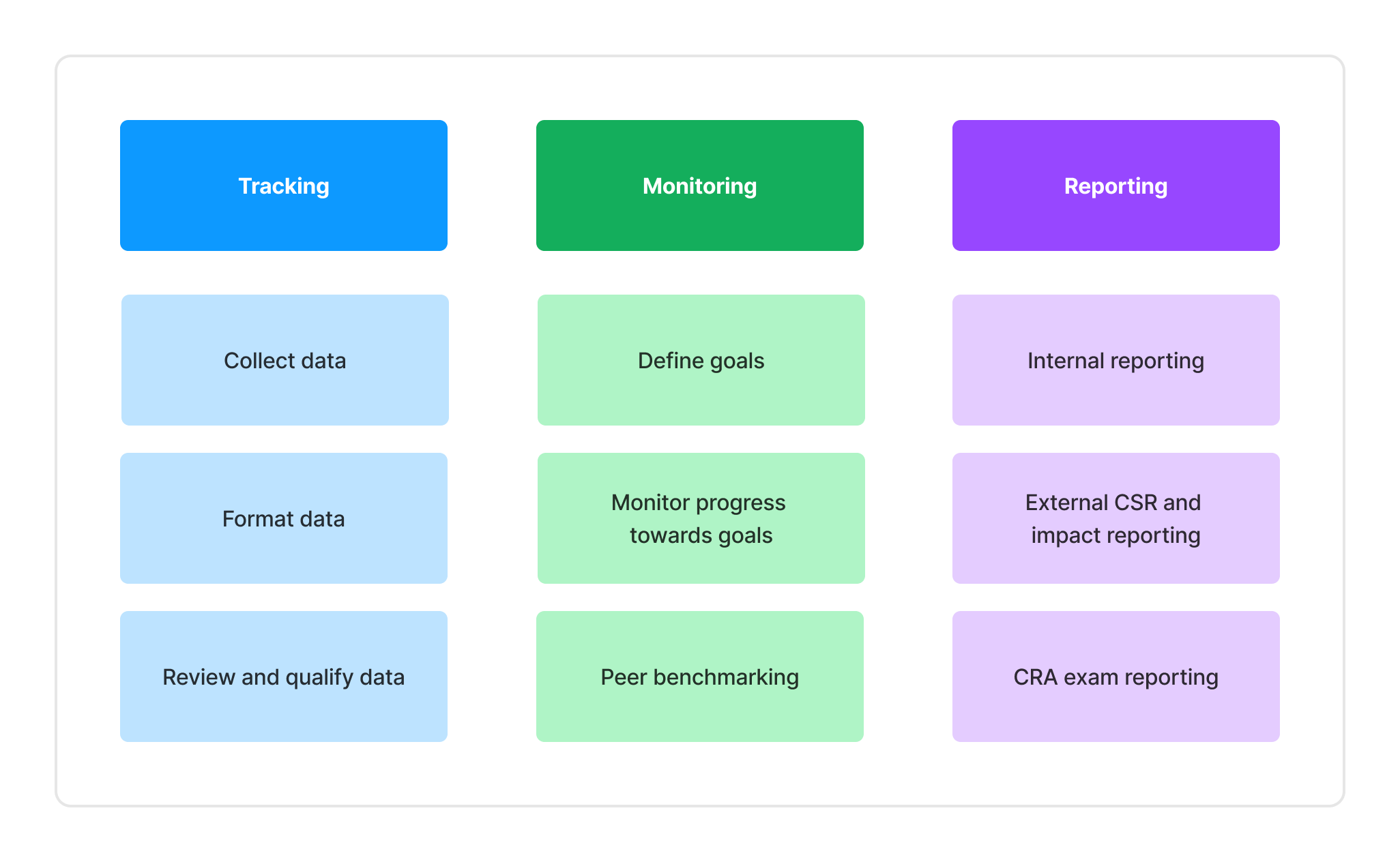Identifying jobs to be done by CSR professionals to develop reporting features: YourCause
Outcome
Enhanced CRA data collection, management, and reporting features were implemented for YourCause as a result of discovery research to better meet the needs of both the business and customer in the CRA space.
By leading a generative research study, I was able to provide the product team with key insights in the form of jobs to be done and written user stories that served as the foundation for defining core product functionality and developing new feature solutions.
YourCause supports over 400 organizations of all sizes.
Problems to solve
Blackbaud provides numerous B2B software solutions that support businesses with their corporate social responsibility (CSR) efforts, one of which is YourCause. A main capability of YourCause is providing customers with a single platform to manage employee volunteering efforts. Many of our financial institution customers who use YourCause to track employee volunteering use that data to report for Community Reinvestment Act (CRA) exams.
The limited CRA reporting features YourCause offers has received low customer satisfaction and often doesn’t solve their needs. Because of this, Blackbaud spends additional internal resourcing hours on custom reporting support from our team.
Our team needed to better understand customer needs surrounding CRA data and reporting in order to understand how to improve and build new product features that meet our customer needs for self-service reporting.
Research and discovery
CRA is a complex topic area that I set out to demystify to equip anyone on our product organization with foundational understanding to build product solutions that meet the needs of our customers.
Objectives
Understand CRA in the context of our business and our customers
Better understand the different jobs to be done by CRA professionals
Understand the key activities involved in the CRA exam reporting process
Methodology
I used a combination of methods in order to collect the information I needed.
Secondary research: reviewing and synthesizing extensive documentation online from federal regulating organizations such as the FRB, FDIC, and the OCC
Subject matter expertise interviews: 2 IDI’s with a subject matter expert from a CRA consulting company
Customer interviews: 8 IDI’s with customer admins of YourCause in CSR roles responsible for CRA reporting for their org, such as CRA officers, compliance specialists, and community development program managers
Secondary research and SME interview sessions helped inform the interview guide for customer interviews. In the 1 hour in-depth interviews with customers, I uncovered more about topics such as:
The different type of activities that are tracked for CRA exam reporting
The process for CRA exam reporting for each type of activity
The type of information and data being measured and collected
How that information and data is being measured collected and managed
Their experience with current CRA features in the YourCause product
Insights
Foundational CRA information
I created a shared understanding of the CRA topic area in the context of our business and our customers:
Identified what parts of the CRA exam evaluation framework applies to our context
Outlined fundamental concepts and terms such as assessment areas and geocoding
Defined 5 key pieces of data needed for qualifying CRA volunteering and community development service activities
Jobs to be done
I identified 3 core functional jobs to be done and corresponding job steps to outline where our team must create value for CRA professionals who are using YourCause to get their job done.
Tracking: collecting, formatting, reviewing and qualifying CRA data
Monitoring: defining CRA goals, monitoring progress, and benchmarking against peer institutions
Reporting: ongoing internal reporting, external CSR reporting, and CRA exam reporting
User stories
I also provided written user stories related to the job steps based on all of the insights gathered from primary and secondary research so that product management could take them directly into feature planning for design and development work.
Tracking user story
“When I am qualifying CRA service activities, I want the charity location and the service event location to be automatically geocoded by the system, so that the system can automatically categorize them into my assessment areas without manually reviewing and sorting them myself.”
Monitoring user story
“I want to define my institution assessment areas in the system so that individual service activity data is automatically tied to an assessment area via the location.”
Reporting user story
“When I am preparing for the CRA exam, I need to export detailed data that has already been reviewed and qualified in the system without having to duplicate my past work.”
Summary
The outcomes of this research study enabled our team to:
conduct a product audit of existing features in YourCause against the user stories to uncover opportunities for improvement
evaluate and prioritize the user stories for new feature development in YourCause
gain a foundational understanding of CRA and maintain a framework rooted in core jobs for ongoing development of CRA functionality and features in YourCause
Enhanced CRA data collection, management, and reporting features that were implemented enabled our organization to reduce costs of custom reporting support add-on’s for customers and increased customer satisfaction of CRA features.
